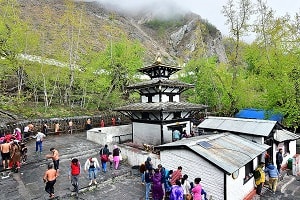 The temple symbolizes the religious symbiosis between Hindus and Buddhists. The origin of this temple is associated with the 19th century and it is believed that this Vishnu Temple was consecrated by Hindus. History of this temple states that Shabkar who was a very famous Tibetan Yogi visited Muktinath in 1818 and rested there for many days so that he could connect well with the place. It is said that the initiative of the construction of this temple was given by Sabarna Prabha, a Nepali Queen.
The temple symbolizes the religious symbiosis between Hindus and Buddhists. The origin of this temple is associated with the 19th century and it is believed that this Vishnu Temple was consecrated by Hindus. History of this temple states that Shabkar who was a very famous Tibetan Yogi visited Muktinath in 1818 and rested there for many days so that he could connect well with the place. It is said that the initiative of the construction of this temple was given by Sabarna Prabha, a Nepali Queen.
Also, Damodar Kunda, a very popular lake which is located nearby the Muktinath Temple is the main source of Shaligram and the Gandaki River. The lake is also called as the starting point of Mukti Kshetra and is also related to the life of Guru Rinpoche. In the Tibetan language, the lake is called as “Men-Chu”.
Importance of Paying Homage at Muktinath Temple
Hindu mythology states that the whole world is an illusion of the life cycle of birth and death and everyone wants to be free from this cycle of birth and death and want to attain liberation. It is believed that a visit to Muktinath helps in achieving the liberation so devotees come here from different places.
The 2 holy water tanks and 108 waterspouts are considered to cleanse the sins committed in the past. So, devotees visiting this temple do take bath in the waterspouts and the Kunds to cleanse themselves from their sins.
Legends behind the Muktinath Temple
Legend 1: It states that Guru Rinpoche who was the founder of Tibetan Buddhism meditated at this place while moving towards Tibet and he attained the lifelong spiritual knowledge from this place. This legend dates back to the 12th century.
Legend 2: For Hindus, Muktinath represents Lord Vishnu and for Buddhists, it represents Mahatma Buddha. There are numerous interesting stories behind the origin of Muktinath. According to a very popular Hindu mythology, there was a battle between Lord Shiva and Jalandhar who was a powerful demon king. Being an evil-minded, Jalandhar crossed his limit and to achieve Goddess Parvati he attacked Kailash. Later on by using his power he transformed himself in Lord Shiva but he couldn’t cheat Goddess Parvati as she had realized it that it was not his husband Lord Shiva so she quickly called out Lord Shiva to help her. A battle started between them but his wife’s trust and faithfulness in Lord Shiva saved him from getting killed. Soon after gods decided to play a trick to destroy that massive evil and then Lord Vishnu duplicated himself into Jalandhar and went to Vrinda. She couldn’t recognize Lord Vishnu and treated as Jalandhar (her husband). Meanwhile, she lost her devotion and Lord Shiva slaughtered the demon. Later on, Vrinda learned the truth of the trick and she gave the curse to Lord Vishnu to spend his rest of the life as a Shila and this is how Muktinath originated and Lord Vishnu started getting worshipped there. After cursing Lord Vishnu, Vrinda killed herself and with her ashes, a Tulsi plant grew there.
After this incident, Lord Vishnu started respecting and loving more to Vrinda than Goddess Lakshmi. Since then, pilgrims visiting Muktinath must get a Tulsi leaf while worshipping the Shaligram.
Legend 3: The other famous legend behind the origin of Muktinath is related to the death of Sati who was the first wife of Lord Shiva. According to Swasthani Brata, Lord Shiva took the dead body of Sati with him and wandered at many places. While he was wandering her body parts had fallen down at many places and wherever it felt down, the place got famed as Shakti Peeth and Muktinath is also one of them. It is believed that her face (called as Mukh in Sanskrit) was fallen down at Muktinath and this is how the place got honored as Muktinath.



 Call
Call WhatsApp
WhatsApp Enquiry
Enquiry